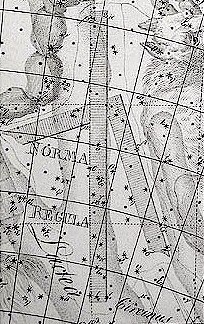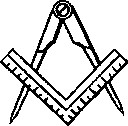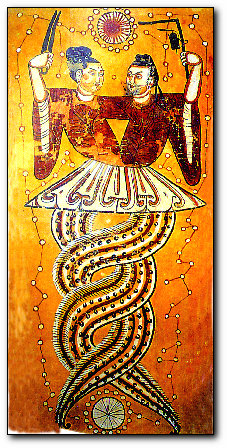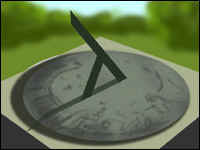 Norma was drawn by Johann Bode in Uranographia as either a ruler, or a level, overlaying a carpenter’s square. Norma is the Latin word for a carpenter’s square, Norma et Regula, literally means the carpenter’s square and ruler, but it seems that the ruler could be a level as Norma et Regula is often translated ‘The Level and the Square’. “In English the constellation is variously known as The Rule, The Carpenter’s Square, The Set Square and The Level. An L-shaped instrument for drawing right angles is called a ‘carpenter’s square‘” []. In carpentry, a square, or set square is a guide for establishing right angles or ninety-degree angles.
Norma was drawn by Johann Bode in Uranographia as either a ruler, or a level, overlaying a carpenter’s square. Norma is the Latin word for a carpenter’s square, Norma et Regula, literally means the carpenter’s square and ruler, but it seems that the ruler could be a level as Norma et Regula is often translated ‘The Level and the Square’. “In English the constellation is variously known as The Rule, The Carpenter’s Square, The Set Square and The Level. An L-shaped instrument for drawing right angles is called a ‘carpenter’s square‘” []. In carpentry, a square, or set square is a guide for establishing right angles or ninety-degree angles.
 This constellation, Norma, ‘the Carpenter’s Square’, and its adjoining constellation Circinus, ‘Pair Of Compasses for drawing circles’, might be taken as a pair. The two together are the emblems of masonry, and the symbol of Freemasonry.
This constellation, Norma, ‘the Carpenter’s Square’, and its adjoining constellation Circinus, ‘Pair Of Compasses for drawing circles’, might be taken as a pair. The two together are the emblems of masonry, and the symbol of Freemasonry.
 There is an older association between these two objects. An ancient painting of Nüwa and Fuxi unearthed in Xinjiang, holding the tools of creation; the compass and square, and surrounded by constellations. Hugh Nibley gave a lecture in 1975 on “Sacred Vestments” in which he says “In the underground tomb of Fan Yen-Shih, d. A.D. 689, two painted silk veils show the First Ancestors of the Chinese, their entwined serpect bodies rotating around the invisible vertical axis mundi. Fu Hsi holds the set-square and plumb bob … as he rules the four-cornered earth, while his sister-wife Nü-wa holds the compass pointing up, as she rules the circling heavens. The phrase kuci chü is used by modern Chinese to signify “the way things should be, the moral standard”; it literally means the compass and the square. (pg. 115)”.
There is an older association between these two objects. An ancient painting of Nüwa and Fuxi unearthed in Xinjiang, holding the tools of creation; the compass and square, and surrounded by constellations. Hugh Nibley gave a lecture in 1975 on “Sacred Vestments” in which he says “In the underground tomb of Fan Yen-Shih, d. A.D. 689, two painted silk veils show the First Ancestors of the Chinese, their entwined serpect bodies rotating around the invisible vertical axis mundi. Fu Hsi holds the set-square and plumb bob … as he rules the four-cornered earth, while his sister-wife Nü-wa holds the compass pointing up, as she rules the circling heavens. The phrase kuci chü is used by modern Chinese to signify “the way things should be, the moral standard”; it literally means the compass and the square. (pg. 115)”.
Giorgio De Santillana, Hertha Von Dechend, in Hamlet’s Mill, p.272, “The two characters surrounded by constellations are Fu Hsi and Nu Kua, i.e., the craftsman god and his paredra, who measure the ‘squareness of the earth’ and the ’roundness of heaven’ with their implements, the square with the plumb bob hanging from it, and the compass. The intertwined serpent-like bodies of the deities indicate clearly enough, although in a peculiar “projection,” circular orbits intersecting each other at regular intervals.” [source
The word Norma comes from Latin norma, with the meaning ‘carpenter’s square, rule, pattern, precept’, from the Indo-European root *gno ‘To know’. Derivatives: know, knowledge, acknowledge, (from Old English cnawan), can¹, con², cunning, (from Old English cunnan), ken, kenning, (from Old English cennan, to declare, to make known), couth, uncouth, (from Old English cuth), kith and kin, (from Old English cyth(the), cyththu), notice, notify, notion, notorious, acquaint, cognition, cognizance, connoisseur, incognito, quaint, recognize, reconnaissance, reconnoiter, (from Latin (g)noscere, cognoscere), ignorant, ignore (from Latin ignorare, not to know, to disregard), noble (from Latin nobilis), noble (the noble gases are inert gases, including gold, that resist oxidation in air at high temperatures), nobility, ignoble,gnome² ( an aphorism, a maxim), gnomon (the style of a sundial, that projects a shadow used as an indicator), gnosis (gnosis is an intuitive apprehension of spiritual truths, an esoteric form of knowledge sought by the Gnostics ), Gnostic, agnosia (loss of the ability to interpret sensory stimuli), agnostic, diagnosis, prognosis, (from Greek gignoskein, to know), narrate (from Latin narrare < *gnararre), ZendAvesta (the body of writings of the Zoroastrian religion), note, annotate, connote, (from Latin nota, a mark, note, sign, cipher, shorthand character), notion, norm, Norma, normal, abnormal, enormous (out of all just rule and proportion), enormity, (from Latin norma, carpenter’s square, rule, pattern, precept, possibly from an Etruscan borrowing of Greek gnomon, carpenter’s square, rule). [Pokorny 2. gen– 376. Watkins] The word snob is sometimes supposed to stand for abbreviated ‘sine nobilitate‘ or ‘sans noblesse‘, ‘without nobility’.
 ] The words Norma and gnomon are from the same root *gno ‘To know’. The Greek word gnomon refers to two different objects; the pointer on a sundial, and also a carpenter’s square or L-shaped bar. The stylus or gnomon of a sundial casts a shadow by which the time is indicated on the dial. The shape of an upright pointer and shadow together have a 90 degree-angle; as has carpenter’s square. Pillars, columns, standing stones, or a stick stuck upright in the ground, serve the same shadow-making purpose as the gnomon or stylus.
] The words Norma and gnomon are from the same root *gno ‘To know’. The Greek word gnomon refers to two different objects; the pointer on a sundial, and also a carpenter’s square or L-shaped bar. The stylus or gnomon of a sundial casts a shadow by which the time is indicated on the dial. The shape of an upright pointer and shadow together have a 90 degree-angle; as has carpenter’s square. Pillars, columns, standing stones, or a stick stuck upright in the ground, serve the same shadow-making purpose as the gnomon or stylus.
Gnomon is the style of a sundial. Gnome is a word coined by the Swiss physician and alchemist Paracelsus (born 1493) for the elementals. Gnomes are a fabled race of dwarflike creatures who live underground and guard treasure hoards. Science tells us that all earth’s elements come from the stars as they die and explode their material out into space, some of which lands on earth. The Romans used the word, elementa, ‘elements’, for letters of the alphabet. Latin elementa is a word derived from LMN, the first three letters of the Etruscan alphabet. This constellation, Norma, was sometimes referred to as Quadra Euclidis, Euclid’s Square, Euclid (323–283 BC) is famous for his book titled Elements‘, a presentation in thirteen books of geometry and other mathematics. In Greek they had a different word for the same meaning, stoichos; an English translation of the German book DESIGN UND ZEIT explains:
“The semantic field of stoichea is: stoicheoma means element, fundamental building block, denotes the idea of a first principle of the cosmos; stoicheoo: to teach the basics; stoicheomata: the 12 signs of the zodiac, stoicheon: letter of the alphabet; stoichos: the rod or stylus of a sundial that casts the shadow by which the time is indicated on the dial. …Why and how might the word stoichea have acquired the meaning of letter-of-alphabet which is usually denoted by the word grammata? Let us create a mental image of a sundial: We see a rod, or stylus, the sun shines, and the stylus casts a shadow. Then we call into memory another memorable fable of Platon (Plato), the cave parable. There, Platon talks about a big cave where miserable humans are chained fast to their seats so they cannot move and only watch the shadows dancing on the cave walls, forever entertaining themselves guessing what these shadows mean and what they stand for. The connection to the stoichea becomes immediately clear. The symbols of the alphabet are viewed as the shaped holes through which the pure light of the divine logos shines. The shadows that are cast on the dial of the sundial or the cave walls are the meanings of those symbols as we perceive them from our lowly perspective. Platon talks in Phaidros, 276a of the grammata as the shadow pictures of the living, animated logos. …” [An English translation of the German book DESIGN UND ZEIT, A Morphology of Cultural Patterns]
Stoichiometry, is the art of determining the atomic and molecular weights of the elements, from Greek stoikeion, meaning both ‘shadow line’ and ‘element’, a derivative of stoikos, stikos, ‘row, line, rank, verse’, steikein, ‘to go, to march in order’, from the Indo-European root *steigh ‘To stride, step, rise’. Derivatives include: sty² (swelling on the eyelid), stirrup (to go up, rise), stile¹ (a set or series of steps for crossing a fence or wall), stickle (to argue or contend stubbornly), stickler, stich (a line of verse), acrostic (a poem or series of lines in which certain letters, usually the first in each line, form a name, motto, or message when read in sequence), cadastre (cadaster from kata stikhon, a comprehensive register of the real property of a country), distich (a unit of verse consisting of two lines), hemistich (a half line of verse), pentastich (a poem or stanza having five lines), stichometry (a term applied to the measurement of ancient texts by rows or verses), stichomythia (an ancient Greek arrangement of dialogue in drama, poetry, from Greek stikhos, row, line, line of verse), stair, stoichiometry, stapes (the innermost of the three small bones of the middle ear, shaped somewhat like a stirrup, also the upper part of the hyoid arch. The bony jaw brace in early fishes, became the stapes, located in a new part of the ear, the middle ear) [Pokorny steigh– 1017. Watkins
The four classical elements are; earth, fire, air, and water.
A gnomon is the style of a sundial, from Greek stulos, pillar, related to stile, a vertical frame, as in a door or window sash. A stylus (Greek stulos) is also a sharp, pointed instrument used for writing, marking, or engraving, also the word for a phonograph needle. It usually refers to a narrow, elongated staff, similar to a modern ballpoint pen [].
Elephant and ivory? In his book Metaformations Frederick Ahl says “The practice of using ivory letters has led some scholars to suggest that the Latin word elementum derives from the Greek elephas, ‘ivory,’ through an intermediate (unattested) Latin form elepantum.” Klein says the change of *elepantum to elementum is probably due to Etruscan influence.
Self-repeating shapes are referred to as gnomons. – Sunflowers and seashells. Fractals, Fibonacci sequences… [
© Anne Wright 2008.
| Fixed stars in Norma | |||||||
| Star | 1900 | 2000 | R A | Decl 1950 | Lat | Mag | Sp |
| delta | 07SAG08 | 08SAG31 | 240 44 13 | -45 02 22 | -23 49 20 | 4.84 | A3 |
| eta | 07SAG29 | 08SAG52 | 239 52 55 | -49 05 32 | -27 54 15 | 4.74 | G4 |
| 1 gamma | 10SAG10 | 11SAG33 | 243 18 56 | -49 56 43 | -28 15 33 | 5.00 | G4 |
| 2 gamma | 10SAG41 | 12SAG04 | 244 01 19 | -50 02 06 | -28 15 22 | 4.14 | G8 |
| epsilon | 11SAG29 | 12SAG52 | 245 52 38 | -47 26 35 | -25 28 47 | 4.80 | B5 |